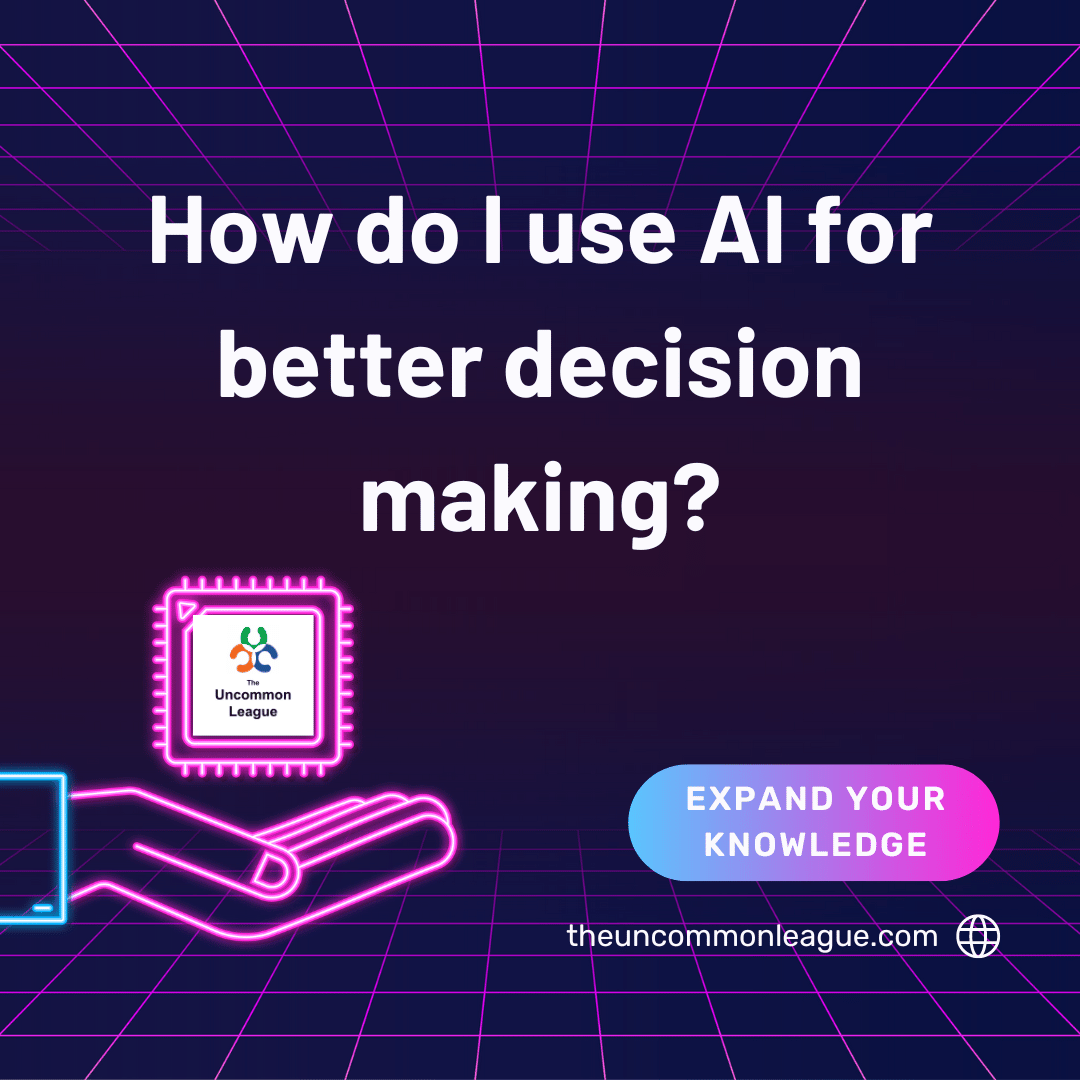How do I use AI for better decision making?
With the advent of artificial intelligence (AI), individuals and organizations now have access to powerful tools that can revolutionize the decision-making process. From predictive analytics to machine learning algorithms, AI technologies offer a plethora of capabilities to analyze data, uncover insights, and optimize decision outcomes. In this article, we explore how to harness the power of AI for decision-making, taking into consideration current trends and tools.
Understanding the Role of AI in Decision-Making
Before delving into specific strategies and tools, it's essential to understand the role of AI in decision-making. AI systems operate by analyzing vast amounts of data, identifying patterns, and generating insights to support decision-making processes. By leveraging advanced algorithms and machine learning techniques, AI can automate repetitive tasks, predict future outcomes, and optimize decision outcomes. Whether in business, finance, healthcare, or other domains, AI can augment human decision-making capabilities and facilitate more informed and efficient decisions.
Data Analysis and Insights: AI systems excel at analyzing complex datasets to extract meaningful insights and patterns. By processing structured and unstructured data from various sources, including sensors, databases, and online platforms, AI can uncover hidden relationships and trends that inform decision-making processes.
Predictive Analytics: Predictive analytics algorithms, a subset of AI, enable organizations to forecast future outcomes based on historical data and trends. By identifying patterns and correlations within datasets, predictive analytics models can anticipate market trends, customer behavior, and potential risks, empowering decision-makers to take proactive measures and mitigate uncertainties.
Decision Optimization: AI-powered decision optimization techniques aim to identify the best course of action among multiple alternatives while considering constraints and objectives. From resource allocation to supply chain management, decision optimization algorithms can help organizations optimize resource utilization, maximize efficiency, and achieve strategic objectives.
Current Trends in AI-driven Decision-Making
To effectively harness AI for decision-making, it's crucial to stay informed about the latest trends shaping this domain. Several trends are driving advancements in AI-driven decision-making capabilities and influencing how organizations leverage AI technologies:
Explainable AI (XAI): As AI systems become more complex and pervasive, there's a growing demand for transparency and interpretability. Explainable AI (XAI) techniques aim to make AI decision-making processes understandable to humans by providing insights into how decisions are made. By enhancing transparency and trust, XAI enables decision-makers to interpret AI recommendations and assess their reliability.
Autonomous Decision-Making: With advancements in AI and robotics, there's an increasing emphasis on autonomous decision-making systems that can operate without human intervention. Autonomous decision-making algorithms, such as reinforcement learning agents, enable AI systems to learn from experience, adapt to changing environments, and make decisions in real-time. From autonomous vehicles to automated trading systems, autonomous decision-making has transformative potential across various domains.
Augmented Intelligence: Augmented intelligence, also known as intelligence augmentation (IA), refers to the symbiotic relationship between humans and AI systems. Unlike artificial general intelligence (AGI), which aims to replicate human-level intelligence, augmented intelligence seeks to enhance human decision-making capabilities by leveraging AI technologies. By combining human intuition with AI-powered analytics, augmented intelligence enables decision-makers to make more informed and effective decisions.
Strategies for Using AI in Decision-Making
Now that we've explored the role of AI in decision-making and current trends in the field, let's discuss actionable strategies for leveraging AI to make better decisions:
Identify Decision-Making Opportunities: Identify decision-making opportunities where AI can add value by analyzing large volumes of data, predicting future outcomes, or optimizing decision outcomes. Prioritize decisions that have significant impact or involve complex variables and uncertainties.
Collect and Prepare Data: Gather relevant data from various sources, including internal databases, external repositories, and real-time streams. Ensure data quality, consistency, and integrity by preprocessing and cleansing the data to remove errors and inconsistencies.
Select Appropriate AI Techniques: Choose AI techniques and algorithms that are suitable for the decision-making task at hand. Depending on the nature of the decision and available data, consider using machine learning, natural language processing, predictive analytics, or decision optimization techniques.
Interpret AI Outputs: Interpret AI outputs and recommendations in the context of the decision-making process. Understand the underlying assumptions, limitations, and uncertainties associated with AI predictions and insights. Collaborate with domain experts to validate AI recommendations and assess their relevance and reliability.
Combine Human Judgment with AI Insights: Combine human judgment with AI insights to make more informed and nuanced decisions. Leverage AI technologies to augment human decision-making capabilities, rather than replacing human judgment entirely. Encourage collaboration and interdisciplinary teamwork to leverage diverse perspectives and expertise.
Monitor and Evaluate Decision Outcomes: Continuously monitor and evaluate decision outcomes to assess the effectiveness and impact of AI-driven decision-making. Measure key performance indicators (KPIs) and metrics to quantify the value generated by AI recommendations and identify opportunities for improvement.
April 15 - 17, 2024 (3 Days)
9:00 am (Central) until 5:00pm (Central)
Online - Live Instructor
Tools for AI-driven Decision-Making
A variety of tools and platforms are available to support AI-driven decision-making across different domains and industries. These tools offer capabilities for data analysis, predictive modeling, decision optimization, and visualization:
Data Analytics Platforms: Data analytics platforms such as Tableau, Power BI, and Google Data Studio enable organizations to visualize and analyze large datasets to uncover insights and patterns. These platforms offer intuitive interfaces for data exploration, visualization, and dashboarding, making it easy for decision-makers to gain actionable insights from data.
Predictive Analytics Software: Predictive analytics software tools like IBM SPSS, SAS Enterprise Miner, and RapidMiner enable organizations to build and deploy predictive models for forecasting future outcomes. These tools offer algorithms and workflows for data preprocessing, feature engineering, model training, and evaluation, empowering decision-makers to make data-driven predictions and decisions.
Decision Optimization Tools: Decision optimization tools such as IBM Decision Optimization, FICO Xpress Optimization, and Gurobi enable organizations to solve complex decision-making problems with multiple constraints and objectives. These tools offer optimization algorithms and solvers for resource allocation, scheduling, logistics, and supply chain management, helping organizations make optimal decisions in dynamic and uncertain environments.
AI-powered Business Intelligence (BI) Platforms: AI-powered BI platforms like Sisense, ThoughtSpot, and Domo combine advanced analytics with natural language processing and machine learning capabilities to deliver actionable insights and recommendations. These platforms leverage AI algorithms to automate data analysis, identify trends, and generate insights, enabling decision-makers to make informed decisions quickly and effectively.
AI Decision Making
AI has the potential to revolutionize decision-making by augmenting human intelligence, automating routine tasks, and uncovering insights from data. By understanding the role of AI in decision-making, staying informed about current trends, and leveraging the right tools and strategies, individuals and organizations can harness the power of AI to make better decisions across various domains and industries. As AI continues to evolve, embracing innovation and adopting a data-driven approach will be essential for staying competitive and driving success in the digital age.
Tags #businessanalysis #ai


